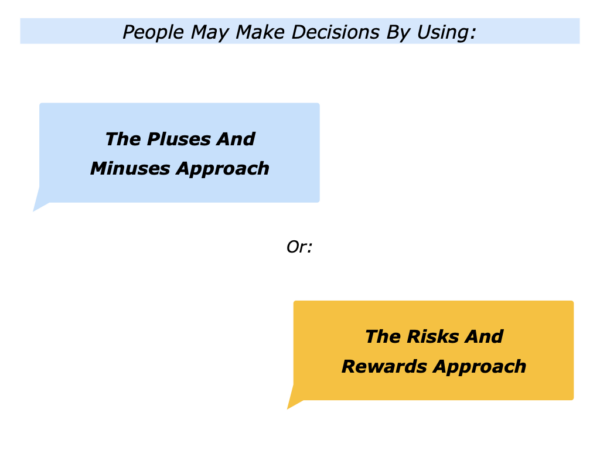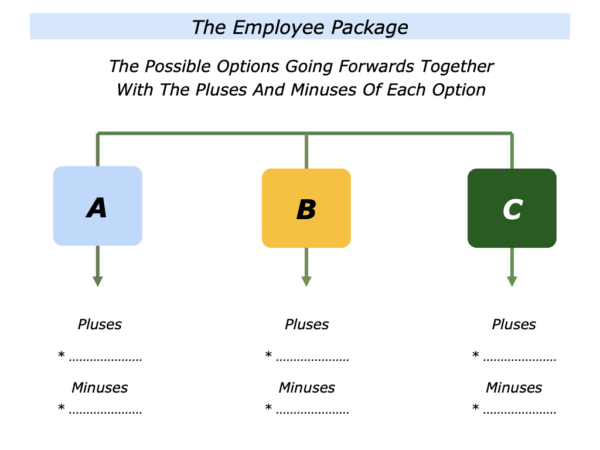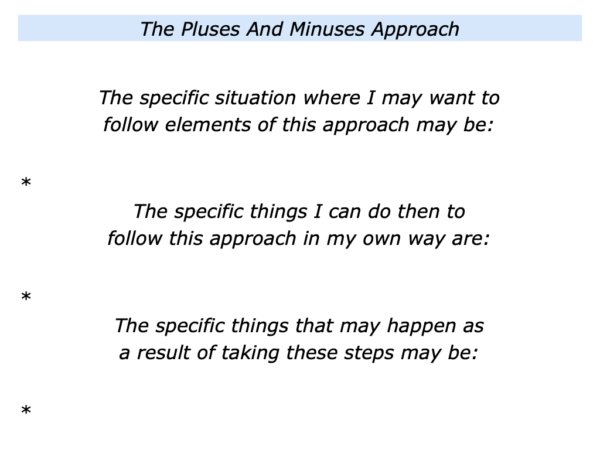
There are many ways to make decisions. This section looks at how people may use the pluses and minuses approach and the risks and rewards approach.
Some people prefer to use the first approach because it removes some of the emotion from the situation. They are then more able to make considered decisions.
Some people find the second approach more challenging because they may worry about what they can lose. This can weigh heavy and lead to them finding it to make a difficult to make a decision. Let’s look at one example.
The Risks And
Rewards Approach
The HR Director of an insurance company asked if we could explore some ideas regarding a proposal they were about to make to their Board. They explained this in the following way.
“I am proposing a new employment package that will enable us to attract and keep good staff. This involves increasing some salaries, providing development opportunities and also improving maternity benefits.
“We need to be seen as a good employer but I have some concerns about how to present the proposal. The Board is rather conservative and I am not sure they will buy into the ideas. Have you any suggestions?”
The HR Director and I explored how they would present the proposal. Coming from an insurance background, they planned to follow their usual approach and do a risk and reward analysis.
Bearing this in mind, I asked how the Board had reacted to this approach on previous occasions. The HR director explained that they this had led:
To lengthy discussions about the risks involved;
To being asked to do further detailed analysis and return with a revised proposal.
Sometimes this resulted in a much watered-down proposal being given the okay. The HR Director wondered how it may be possible to get the Board to accept the proposal about the employment package.
Looking ahead, we explored another way to present the proposal. This involved using the following model.
The Pluses And
Minuses Approach
The HR Director felt passionately about the employment package proposal. But it would be important for them to present this in a considered way.
They would start the presentation by giving some context. This would include describing how companies similar to their own were upping the game in terms of employment packages. They would then aim:
To outline the possible options going forwards – together with the pluses and minuses of each option;
To ask if there were any other options the Board would like to add and, if asked, give their own recommendation;
To invite the Board to discuss the ideas and, when appropriate, decide which route they wanted to go regarding the employment package.

What if the Board chose a route that the HR Director found difficult to pursue? It would be important to stay calm, buy time to think and then consider the best way forwards.
Presenting The Options
The HR Director started the presentation by outlining the context. They then described the potential options going forwards. Here is a summary of the routes they outlined.
Option A: To continue to maintain
the present employment policies
The pluses included the following. It would cost roughly the same as now with a few increases for inflation, it would remain reasonably attractive to some employees and not require any changes in processes.
The potential minuses included the following. It would not necessarily retain or attract certain kinds of staff and also not match the benefits that similar companies were offering.
Option B: To offer an employment package that was
equivalent to those offered by similar companies
The pluses included the following. It would put the company in a better position to attract and retain good staff, enable people to develop and also encourage them to make their best contributions to the company.
The potential minuses included the following. It would cost more money than at present and was not guaranteed to attract or retain all the good staff.
Option C: To offer an employment package that was
more attractive than that provided by similar companies
The pluses included the following. It could make the company an employer of choice and, providing certain cultural issues were improved, it could lead to boosts in morale and productivity.
The potential minuses included the following. It would require more financial investment and, even if there were big improvements in aspects of the culture, it would not necessarily guarantee better performance.
The HR Director presented these options to the Board and asked if they would like to add any other ideas. This led to many detailed questions about the packages being offered by comparative companies.
Another option was to maintain the present conditions for current staff and better deals for new staff. But this was rejected as divisive and could lead to many problems.
The HR Director did not consciously follow the Goldilocks Principle. As we know, this says that people sometime choose the option that seems to have ‘just the right amount of something’. But the Board did opt for the middle approach.
They settled on pursuing Option B – offering a similar employment package to their competitors – but with some provisos. The HR Director was asked to draw up plans for pursuing this option but in a cost effective way.
Such an approach could prove a challenge, especially as the HR Director’s preference was Option C – providing a package that was better than their competitors.
They threw themselves into the task, however, and produced a plan that: a) would be attractive to both present and future employees; b) showed cost effective benefits.
The HR Director’s next step was to have one-to-one meetings with the Board members. They wanted to share the potential employment package with them on an individual basis and get their input. They would then present the final package to the Board.
This approach worked. Whilst the HR Director would have preferred the package to be more ambitious, it was certainly better than maintaining the present conditions. They then focused on implementing the plan successfully.
There are many ways to make decisions. Some people follow the risk and reward approach. But this can get bogged down in people worrying about what they may lose.
Some people therefore prefer the pluses and minuses approach. This can involve making decisions in a more considered way. The aim is then to build on the pluses and minimise the minuses.
Let’s return to your own life and work. Looking ahead, can you think of a situation where you may want to use the pluses and minuses approach? How can you do this in your own way?
If you wish, try tackling the exercise on this theme. This invites you to complete the following sentences.







Leave a Reply